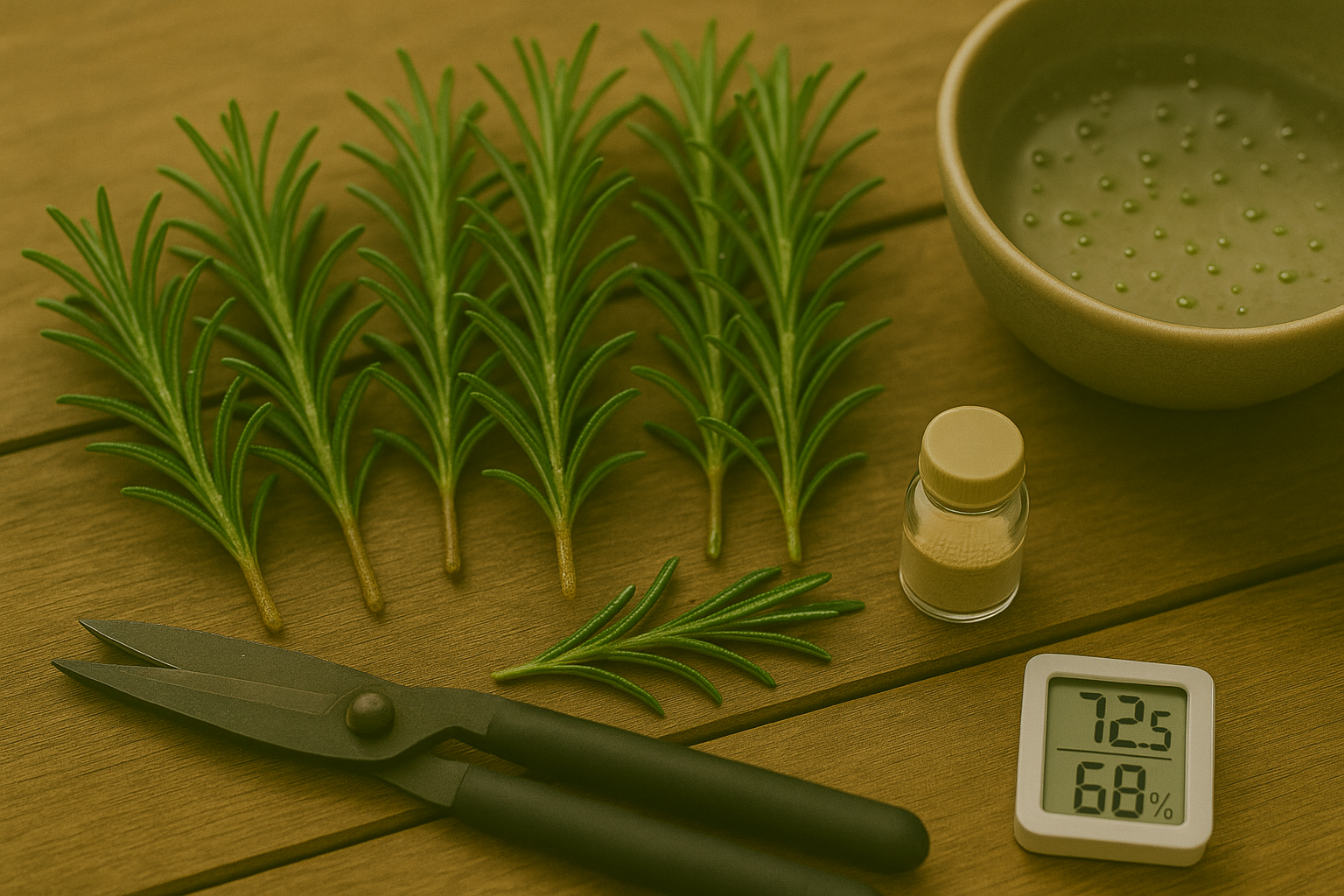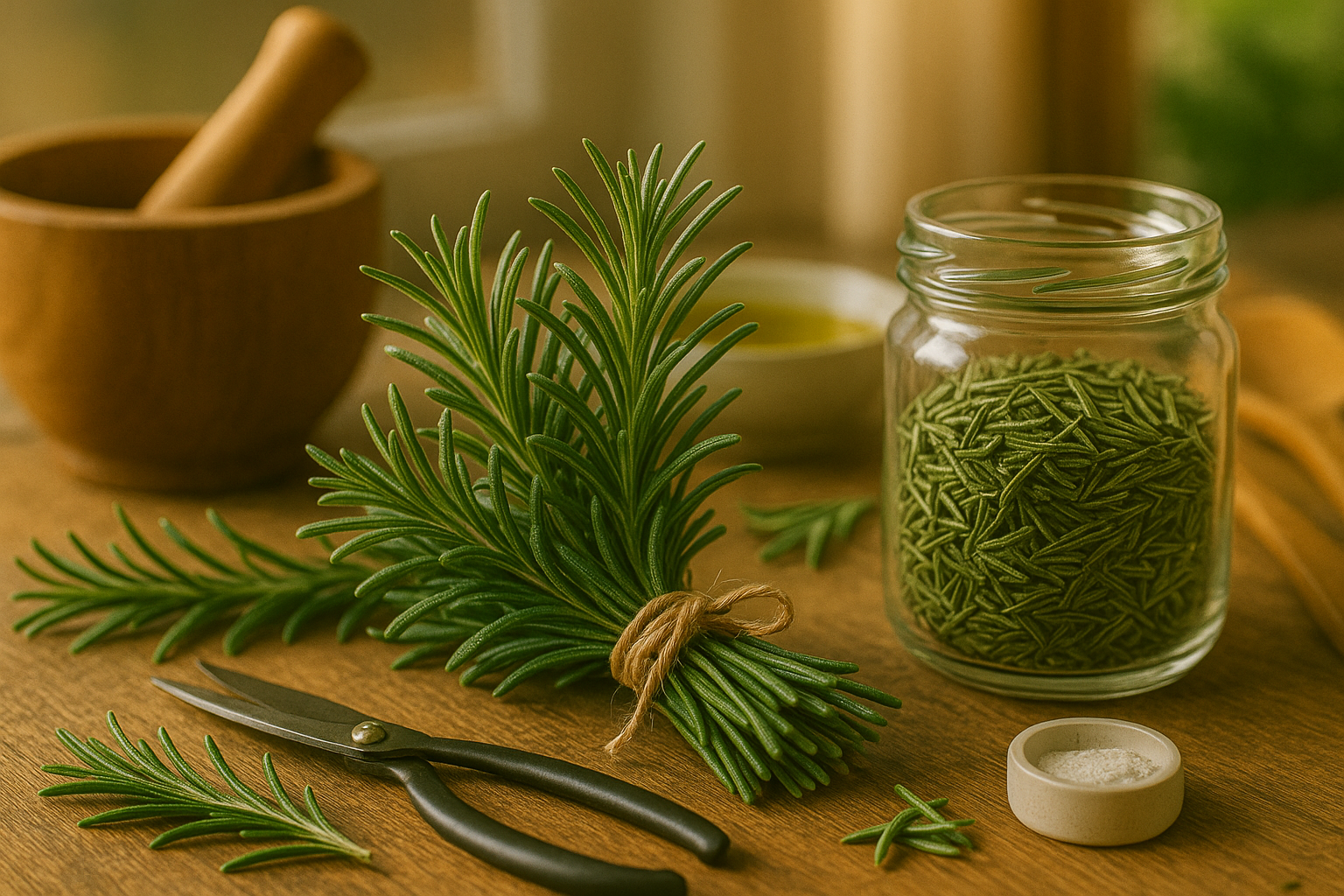Introduction
Drying rosemary at home isn’t just about preserving an herb—it’s about capturing the fresh, piney intensity that makes rosemary a culinary favorite in kitchens worldwide. This fragrant herb is renowned for its bold flavor and health-boosting antioxidant properties, but fresh sprigs can wilt quickly in the fridge. By drying rosemary yourself, you can lock in its essence and enjoy homegrown flavor all year long, whether you’re seasoning roast chicken, tossing it into potato dishes, or brewing an herbal tea.
The best time to harvest rosemary for drying is just before it flowers, usually in late spring or early summer; that’s when the oils—and therefore the flavor—are most concentrated. Snip the stems in the morning after the dew has dried for peak aroma.
While grabbing a jar from the store shelf is convenient, homemade dried rosemary often retains more of its pungent oils and natural color, giving your dishes a fresher, more vibrant taste. Plus, you skip preservatives and can dry only what you need, reducing waste.
Whether you grow rosemary in a backyard garden or a sunny windowsill pot, learning to dry it yourself is a simple way to upgrade your spice game with superior, home-crafted results.
Harvesting Rosemary for Drying

To get the best flavor and aroma from your rosemary, harvest it in late spring or early summer, ideally just before the plant flowers when the essential oils are at their strongest. Aim to cut the stems in the morning, after the dew has dried but before the day heats up, as this helps preserve the natural oils and freshness.
Look for healthy, green stems—avoid any that are brown or woody. Use clean, sharp scissors or pruning shears, and only take up to a third of the plant at a time to ensure it keeps growing strong.
After cutting, gently shake the stems or swish them in cool water to remove any dirt or insects. Lay the rosemary out on a clean towel and pat it dry, then allow any residual moisture to air dry before you begin the drying process. This simple care helps protect both the flavor and the health of your rosemary plant for future harvests.
Best Methods to Dry Rosemary
Drying rosemary at home is super easy, and you’ve got plenty of methods to choose from.
Air-Drying
This is the most traditional and energy-saving way. Simply tie small bundles of rosemary sprigs and hang them upside down in a dry, well-ventilated space for about two weeks. It’s simple, requires only string and patience, but works best in dry climates and does take a bit longer.
Oven-Drying
For quicker results, try oven-drying: spread rosemary in a single layer on a baking sheet and set your oven to its lowest temperature (usually around 180°F/82°C). Check frequently and turn the sprigs to prevent burning—they should be dry in about 2 hours. Keep an eye on them, as ovens can heat unevenly.
Using a Dehydrator
If you have a dehydrator, you’ll get reliable, even drying. Arrange the sprigs in a single layer, set the machine to 95°F-115°F (35°C-46°C), and dry for 1-4 hours depending on humidity. Dehydrators are perfect for bigger batches and free up oven space, though you do need the equipment.
Microwave Method
For a speedy fix with small amounts, try the microwave. Sandwich rosemary between paper towels and microwave in 1-minute intervals (usually 2-3 minutes total). It’s super fast and convenient but can cook rather than dry the herbs if you’re not careful. Use caution and don’t leave it unattended.
Final Tips
- Always wash your rosemary thoroughly, pat it dry, and check for bugs or dirt.
- If sensitive to the oils, wear gloves while handling.
- Avoid overheating to keep the best flavor intact.
- Store dried leaves in an airtight container in a cool, dark spot to enjoy fresh garden flavor all year round!
Step-by-Step

To air-dry rosemary, start by gathering fresh sprigs and gently shaking off any dirt or bugs. There’s no need to wash them unless they’re very dirty, as excess moisture can encourage mold. Next, bundle 4-6 stems together and tie the ends with kitchen twine or rubber bands, making sure the bundles are snug but not cramped.
Hang the bunches upside down in a well-ventilated, dry place away from direct sunlight; a kitchen window with a slight breeze or a covered porch works well. Space the bundles so they aren’t touching to allow airflow, which helps prevent mildew. Depending on humidity, rosemary usually dries in 1 to 2 weeks.
To test for dryness, try snapping a leaf or stem—it should feel brittle and break cleanly, not bend. If it’s still flexible, give it more time. If you notice any moldy smell, dark spots, or a limp feel, remove the affected stems and improve ventilation. Using a fan on low nearby can help circulation.
Avoid drying rosemary in a damp basement or bathroom, as these areas can trap moisture and encourage spoilage. Once thoroughly dry, strip the leaves from the stems and store them in an airtight container in a cool, dark spot. Properly dried rosemary will keep its aroma and flavor for up to a year.
Quick Alternatives
Oven-drying rosemary is a fast and reliable method—just preheat your oven to its lowest setting, ideally around 180°F (80°C). Spread the rosemary sprigs in a single layer on a baking sheet lined with parchment paper, making sure they’re not stacked or overcrowded.
Pop the tray in the oven, leaving the oven door slightly ajar to let moisture escape. Check on the rosemary every 15 minutes, gently stirring or turning the sprigs to ensure even drying. The whole process should take 30-45 minutes; pull the rosemary out as soon as the leaves feel crisp but are still green, not brown.
For even quicker results, the microwave works well for small amounts: lay rosemary between two paper towels on a microwave-safe plate, and heat on high for 20-second bursts, checking and rearranging after each round to prevent burning. Most microwaves will dry a handful of rosemary in under two minutes—just watch closely!
To keep the rosemary’s flavor and color as vibrant as possible, dry only what you need, avoid high heat, and transfer cooled, dried leaves immediately to an airtight container away from sunlight. This prevents bitterness and dullness, giving you beautifully fragrant herbs ready for your next recipe.
Storing Dried Rosemary for Maximum Freshness
After drying your rosemary, let it cool completely before storing to prevent trapped moisture, which can lead to mold. Gently strip the dried leaves from the stems by sliding your fingers down each sprig. This quick method ensures you keep only the most flavorful parts.
For best results, transfer the leaves into an airtight container like a glass jar with a tight-sealing lid or a food-grade plastic container. Avoid using bags unless they seal well and block light. Store your rosemary in a cool, dark place such as a pantry or kitchen cupboard, away from heat, sunlight, and humidity.
Always label your storage container with the herb’s name and the date it was dried. This helps you track freshness easily. To maximize shelf life, keep the container tightly closed after each use and check the leaves regularly. If their color fades significantly or the aroma weakens, it’s time to refresh your supply.
Properly stored, dried rosemary can retain its potent flavor and fragrance for up to a year, ensuring you always have a flavorful herb ready for your favorite dishes.
Creative Ways to Use Dried Rosemary
Dried rosemary is a versatile herb that goes far beyond the usual roast chicken or potatoes. Sprinkle it over homemade focaccia bread, stir it into olive oil for a fragrant dipping sauce, or add a pinch to seasoning blends for grilled meats and veggies.
For a simple yet impressive dinner, toss dried rosemary with sea salt and lemon zest, then rub the mixture onto pork or lamb before roasting.
Beyond the kitchen, dried rosemary shines in creative DIY projects. Mix it with lavender and citrus peels to create homemade potpourri, or stuff it into small fabric sachets to freshen drawers and closets. You can even simmer rosemary with water and vinegar to make a natural household cleaner that leaves rooms smelling crisp and herbal.
If you’re looking for unique, budget-friendly gifts, try filling mini jars with rosemary-infused olive oil or creating tiny bundles tied with twine for aromatic kitchen decor. With just a handful of dried rosemary, your pantry can supply everything from weeknight dinners to thoughtful homemade presents.
FAQs & Troubleshooting
Dried rosemary is more potent than fresh, so use about one-third the amount in recipes to avoid overpowering flavors. If you want it to resemble fresh rosemary for soups or stews, briefly soak it in warm water to rehydrate and soften the leaves before adding.
When stored in an airtight container away from heat and light, dried rosemary can last up to two years. However, its flavor gradually fades over time. If it smells musty or bland, it’s time to replace it.
Keep an eye out for any signs of mold, which usually occurs from moisture exposure. If mold appears, discard the entire batch immediately.
To prevent over-drying—which results in brittle, flavorless needles—check the texture during the drying process. The rosemary should crumble easily but still retain a fresh, herbal scent. If your rosemary has lost its aroma or tastes stale, it’s best to toss it and start fresh for the best flavor in your dishes.
